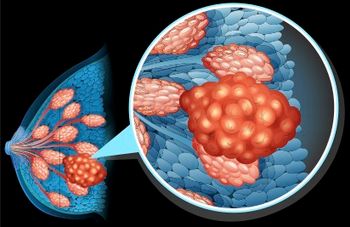
Oncology NEWS International
- Oncology NEWS International Vol 9 No 10
- Volume 9
- Issue 10
Adjuvant Tamoxifen Equally Effective in Black and White Breast Cancer Patients
NEW ORLEANS-Adjuvant tam-oxifen (Nolvadex) is as effective among black women as among white women in reducing the incidence of contralateral breast cancer, according to a retrospective analysis of nine trials from the National Surgical Adjuvant Breast and Bowel Project (NSABP) (B-13 through B-20 and B-22). In addition, increases in endometrial cancer with tamoxifen use are similar for both races.
NEW ORLEANSAdjuvant tam-oxifen (Nolvadex) is as effective among black women as among white women in reducing the incidence of contralateral breast cancer, according to a retrospective analysis of nine trials from the National Surgical Adjuvant Breast and Bowel Project (NSABP) (B-13 through B-20 and B-22). In addition, increases in endometrial cancer with tamoxifen use are similar for both races.
Worta McCaskill-Stevens, MD, of the National Cancer Institute, presented the findings at the 36th Annual Meeting of the American Society of Clinical Oncology (ASCO).
Results Important
The results are important because the relative benefit of tamoxifen among black women has not been thoroughly assessed in clinical trials and has been considered to be uncertain, said ASCO session moderator, Frankie Ann Holmes, MD, of US Oncology, Houston.
Dr. Holmes said that discussions at recent conferences indicated that you could not automatically assume that African-American women would have the same degree of benefit as Caucasian women because African-American women have a higher incidence of hypertension, uncontrolled hypertension, and cardiovascular disease.
The analysis included outcome data from 15,016 patients, of whom 1,212 (8%) were black. That percentage, Dr. McCaskill-Stevens said, matches the black demographics in the United States. The other patients were white (n = 12,932) or of other/unknown race (n = 872).
Women with a personal history of breast cancer are at increased risk for developing a second primary tumor. Depending on age at diagnosis and other factors, 2% to 11% will develop contralateral disease in their lifetime, she said.
In the analysis Dr. McCaskill-Stevens and her colleagues compared rates of contralateral breast cancer, endometrial cancer, and thromboembolic events (superficial phlebitis, deep vein thrombosis, or pulmonary embolism).
All of the NSABP trials were double blind and placebo-controlled, and included 5 years of tamoxifen therapy. Four trials included only women who were estrogen-receptor (ER) positive and node negative. Three trials allowed node-positive patients.
Among white women (55% of whom were age 50 are older), 71% and 63% were ER and progestin-receptor positive, respectively, compared with 55% and 48% of black women (45% of whom were age 50 or older). Nodes were positive in 43% of white women and 52% of black women.
The annual rate of contralateral breast cancer per 1,000 at-risk patients is strongly dependent on whether the patient is treated with tamoxifen, Dr. McCaskill-Stevens said.
She said that the annualized rate of 7.4 per 1,000 cases was nearly uniform across the seven trials with study arms without tamoxifen. For those study arms with tamoxifen, the rate was 4.4 per 1,000, representing a 41% reduction in risk.
Dr. McCaskill-Stevens also said that the contralateral breast cancer rate following primary breast cancer without tamoxifen use was higher among blacks (9.6% vs 7.2% for whites).
The reduction in risk, however, was nearly identical for both groups. The contralateral breast cancer rate dropped to 5.5% (RR 0.57, a 43% reduction) for black women with tamoxifen therapy, and to 4.4% (RR 0.61, a 39% reduction) for white women.
Rates of endometrial cancer increased with tamoxifen in black women from 0% to 0.8% and in white women from 0.4% to 2.0%. The difference was not significant. Rates were similar to those recorded in other trials, she noted.
Thromboembolic events increased three- to fourfold in both groups with use of tamoxifen (in blacks, from 1.4% to 3.2%, and in whites, from 1.2% to 4.7%).
Differences in risk and the relative effect of tamoxifen use, after controlling for protocol, tamoxifen use, chemotherapy, age, and body mass index, were not significant, Dr. McCaskill-Stevens said. Differences in effects of receptor and nodal status were also not significant between the two groups, she added.
In summary, after adjustments for relevant prognostic factors, African-American women had a higher rate of contralateral breast cancer, but the difference was not significant. . . . Efficacy appears to be unrelated to racial differences, Dr. McCaskill-Stevens concluded.
Dr. Holmes commented, I am particularly gratified to see this abstract . . . [and] to know that I can confidently use tamoxifen to reduce the risk of breast cancer in my African-American pa-tients.
Articles in this issue
about 25 years ago
HER-2/neu Activation May Predict Breast Cancer Prognosisabout 25 years ago
Company Offers Computer-Aided Detection of Breast Cancerabout 25 years ago
ASBD, an Interdisciplinary Group, Fights Breast Cancerabout 25 years ago
How Employers Can Help Caregivers in the Workplaceabout 25 years ago
Only Slight Improvement in Hepatocellular Carcinoma Survivalabout 25 years ago
New BRCA1 Mutations Found in Black and Hispanic Womenabout 25 years ago
Study Shows Profile of At-Risk Elderly Lung Cancer Patientsabout 25 years ago
Scientific Studies Support Strategies to Curb Nicotine Addictionabout 25 years ago
Smoking Declines Among High School Males, But Not Femalesabout 25 years ago
Cuts in Medicare Reimbursement for Cancer Drugs on HoldNewsletter
Stay up to date on recent advances in the multidisciplinary approach to cancer.


















































































